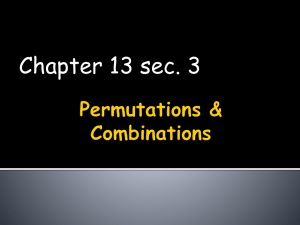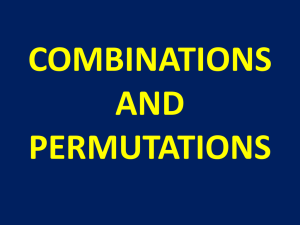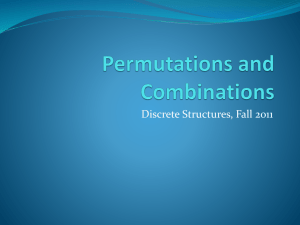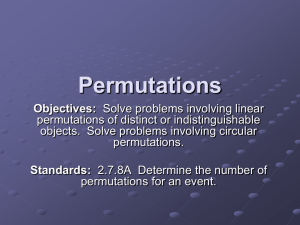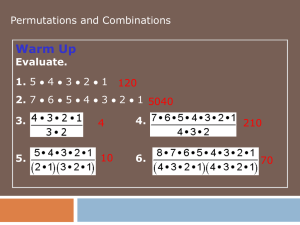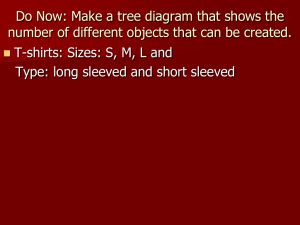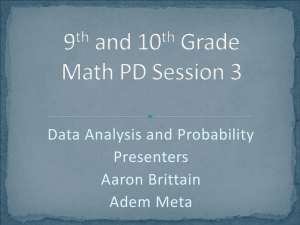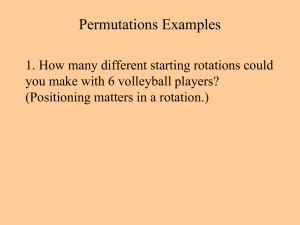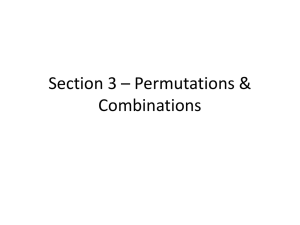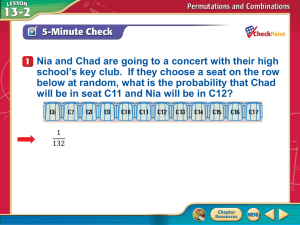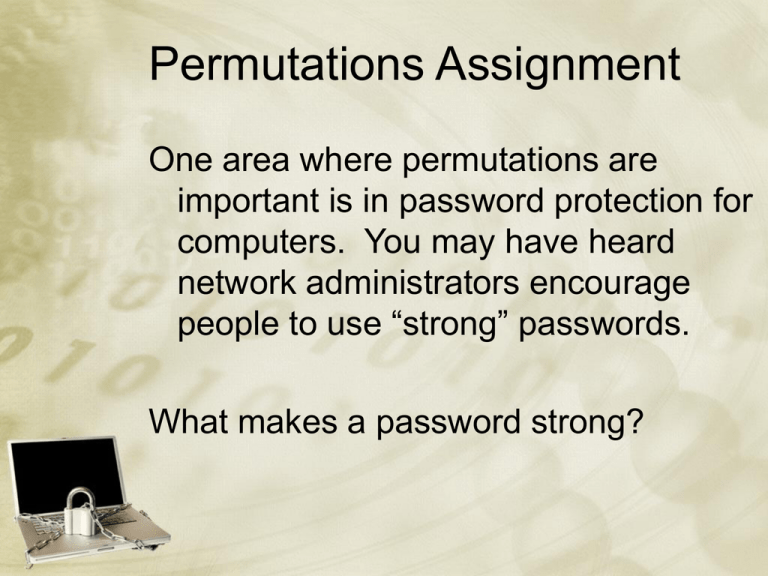
Permutations Assignment
One area where permutations are
important is in password protection for
computers. You may have heard
network administrators encourage
people to use “strong” passwords.
What makes a password strong?
Permutations Assignment
Several factors contribute to a strong
password. In short, it should be
difficult for a hacker to guess what it
is. That’s why one guideline is to not
use words contained in a dictionary—
a dictionary in any language.
Permutations Assignment
In addition, guidelines usually include a
minimum number of characters, as
well as a combination of types of
characters (lower case, upper case,
number, etc.)
Permutations Assignment
Example: How many passwords are
possible if a person uses 3 lower case
letters?
Permutations Assignment
Example: How many passwords are
possible if a person uses 3 lower case
letters?
Using the multiplication principle, each
character has 26 possibilities.
26*26*26 = 17,576 possible passwords
Permutations Assignment
Example: How many passwords are
possible if a person uses 3 lower case
letters?
Working through 17,576 possibilities by
hand would be very time consuming,
but using a computer program to hack
the password would be very simple.
Permutations Assignment
Example: How many passwords are possible
if a person uses 5 letters, combining lower
and upper case?
Each position now has 52 possibilities,
meaning there are
52*52*52*52*52 = 380,204,032 possible
passwords—quite an increase compared to
the previous example!
Permutations Assignment
Problem 1: How many passwords are
possible if a person uses 8 letters,
combining lower and upper case?
Problem 2: How many passwords are
possible if a person uses 6
characters, including lower and upper
case letters and the numbers 0-9?
Permutations Assignment
Problem 3: How many passwords are
possible if a person uses 5 characters,
combining lower and upper case letters,
the numbers 0-9, and the characters [!, ., #,
$, %, &, *, ,, ?]?
Problem 4: How many passwords are
possible if a person uses 8 characters,
combining lower and upper case letters,
the numbers 0-9, and the characters [!, ., #,
$, %, &, *, ,, ?]?
Permutations Assignment
Problem 5: You are a judge in a talent
contest. In how many ways can you rank
your top 3 choices among 10 contestants?
(Order matters—you will rank them 1st, 2nd,
and 3rd.)
Problem 6: The talent contest has grown. In
how many ways can you rank your top 3
choices among 15 contestants?
Permutations Assignment
Problem 7: How many routes are
possible from Prad to Goze? (Include
only routes that visit no city more than
once.)
Lea
Prad
Goze
Permutations Assignment
Problem 8: In the U.S., radio station call
letters must begin with either K or W.
They must consist of either 3 or 4
letters. With these constraints, how
many different radio stations could be
assigned call letters? (A letter may be
used more than once in a station’s
call letters.)
Permutations Assignment
Problem 9: In the U.S., three-digit area
codes started being used in 1947. At
that time, the first digit could not be a
0 or 1, the second digit had to be
either a 0 or 1, and the third digit
could not be 0. How many area
codes were possible in 1947?
Permutations Assignment
Problem 10: To increase the number of
available area codes, as of 1995 the
second digit could be any number 09. How many area codes were
possible starting in 1995? (The
previous constraints regarding the
first and third digits remain in place.)
Permutations Assignment
Problem 11: You are taking a
True/False quiz with 10 problems. In
how many different ways can you
complete the quiz? (For example,
answering every question True counts
as 1 possibility.)
(Hint: Remember the multiplication
principle!)
Permutations Assignment
Problem 12: Unfortunately you are ill
prepared for the quiz and have
decided to totally guess on every
problem. What is the probability that
you will score 100% on the quiz?
(Hint: think about how many ways there
are to answer the quiz, and how many
answer keys there are.)
Background designs are the
property of Geetesh
Bajaj. Used with
permission. © Copyright,
Geetesh Bajaj. All Rights
Reserved.

